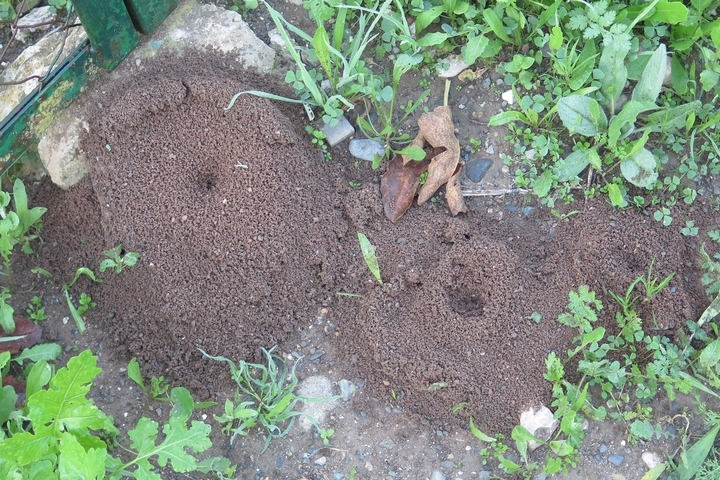
Ant hills are home and breeding grounds for ants, constructed from soil or dirt. These structures vary in size, spanning from tiny protrusions to grand mounds. The ant hill is the heart of an ant colony, offering a haven for its inhabitants and their eggs.
Although ants boast meaningful ecological functions such as aerating soil and managing other pest populations, their hills may still cause issues. Ant hills can ruin otherwise pristine lawns and recreational areas. The presence of a hill could signal a more severe ant infestation or even harm nearby plants and grass. Troublesome ant species, like fire ants, could also bite or sting those who disturb them.
Various environmentally friendly methods exist to eliminate ant hills without damaging the lawn. Options range from natural solutions like boiling water or vinegar concoctions to physically removing the hills or opting for specialized ant baits that target ants with minimal impact on your lawn. Selecting safe methods for people, pets, and our environment is essential.
Let’s learn how to get rid of ant hills without killing grass.
Boiling water treatment.
The boiling water technique is a simple but effective way to address ant hills without damaging nearby grass. This approach entails directly pouring hot water on the ant hills. It serves as an effective means of eradicating ants and interfering with their nest configurations. The heated water seeps into the ant hill, accessing concealed chambers and pathways. It wipes out ants and their eggs, regulating ant populations and staving off additional infestations.
Avoiding potential burns or scalds is essential when executing the boiling water treatment. Meticulously pour the water onto the ant hill, ensuring it covers the entire nest. It is advisable to employ a kettle or a receptacle featuring a spout for enhanced control over water dispensation. This method exhibits maximum efficacy when used on small ant hills or isolated mounds.
Vinegar solution application.
A vinegar solution offers a natural and eco-conscious method to eradicate ant hills without damaging nearby grass. Vinegar, particularly white vinegar, is composed of acetic acid. This acid interferes with ants’ sensory receptors, disrupting their navigation and communication skills. Dousing or spraying a vinegar mixture directly onto the ant hills can produce an unwelcoming atmosphere for ants, persuading them to leave the area.
To employ vinegar as an ant hill remedy, blend equal portions of water and white vinegar in a spray container. Drench the ant hills with this concoction, ensuring vinegar permeates the tunnels and chambers where ants dwell. Additionally, vinegar’s potent aroma is a repellent, rendering the area less attractive to ants.
However, vinegar might only be effective for small ant hills or mild infestations. Integrating vinegar with other ant control techniques may be required to achieve desired outcomes and lasting prevention in cases of larger or more tenacious ant issues.
Physical removal of ant hills.
Eradicating ant colonies through physical removal is a hands-on method that avoids damaging chemicals or pesticides. This technique entails manually digging up and extracting ant hills from the earth with a garden trowel, shovel, or another suitable instrument. By physically displacing the ant hills, you dismantle the nest’s structure, scattering the ants and prompting them to find new dwellings.
Remember to don protective gloves while physically removing ant hills to shield against possible bites or stings from ants. Gently dig around the ant hill, loosening the soil to reveal the intricate tunnels and chambers within.
After unearthing the nest, use your tool to scoop up the soil and the ants, transferring them to a securely sealed bag or container. Safely dispose of soil infested with ants away from your property to avert re-infestation. Remember that this method can be more effective when dealing with smaller ant hills or those located away from larger mounds.
Ant bait placement.
Ant bait can outwit ants by capitalizing on their foraging habits. These clever baits combine enticing food sources with slow-acting insecticides poisonous to ants. Cleverly placed, the baits attract ants in areas where they’re frequently spotted.
Enamoured by the bait, the ants devour it and lug it back home to their colony, sharing it with all its residents, including the queen. This cunning approach paves the way for the steady eradication of the entire ant colony.
To effectively set up these ant baits, always follow manufacturer guidelines with the utmost care. Plant bait stations near high-activity zones while keeping them safe from curious children and pets to avoid harmful ingestion.
Steer clear of repellent-based baits, as they may unintentionally disperse ants and dampen the treatment potency. Watch those bait stations diligently and top them up as necessary. As you embark on this adventure in ant control, patience is key – it might take a while for the bait to make its way through the colony and work its magic.
Diatomaceous earth sprinkling.
Diatomaceous earth offers a natural, non-toxic solution to managing ant hills without harming nearby grass. Crafted from diatom fossils, these tiny algae possess sharp, abrasive edges. Spreading diatomaceous earth around ant hills or areas with activity forms a physical barrier that fractures the ants’ exoskeleton upon contact. It results in dehydration and eventually leads to their downfall.
For optimum ant control, sprinkle a thin, even layer of diatomaceous earth around ant hills. Concentrate on areas where ants are frequently spotted or where they enter your property. Make sure diatomaceous earth directly touches the ants. Remember to use food-grade diatomaceous earth since the pool-grade version is unsafe for humans or animals.
Although diatomaceous earth effectively combats ants, it may also impact beneficial insects. Apply it judiciously and avoid placing it in zones frequented by pollinators or helpful insects. Regular reapplication might be needed after rain or when the diatomaceous earth becomes damp because its effectiveness diminishes when wet.












